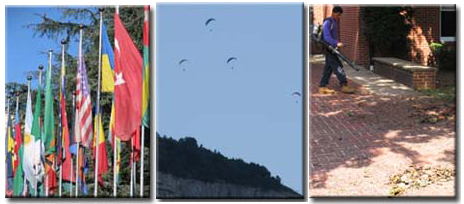Teaching and Learning Focus
These first investigations of weather offer a set of experiences and thoughtful discussions to help your students understand that air is matter that can be experienced and measured. Some of the measurements and observations your students make will be similar to those used by meteorologists to forecast the weather.
Materials Needed
- Classroom or similar space
- Classroom objects such as: chair, easel, student desk, books, sports equipment, etc.
- Photographs showing flags flying, kite in the sky, fallen leaves and trees, leaf-blower at work (example below)
- Ping-pong ball

All images © Laura Middaugh Rios
What is moving the flags? What is holding up the parachutes? What is blowing the leaves here?
Safety
This investigation is considered generally safe to do with students. However, please review it for your specific setting, materials, students, and conventional safety precautions.
Setting the Scene
To introduce students to ideas about air, they first need to realize that air is something, and that it takes up space. This first part of the investigation is designed to get them interested in learning more about air.
Place some simple objects between yourself and the group (e.g., a chair, an easel, a student desk, etc). Ask the students what lies between you and the group. As they name each item, take it away until it appears that there is "nothing" standing between you and the students. Then ask, "Is there anything else between us?" Some, maybe all, will answer that there is nothing left.
Presenting the Investigation Question
After the scene is set, introduce your students to the investigation question: "If air is invisible, how can we know it is there?"
Tell your students that they will be investigating this question and that at the end of their investigations, they will be able to provide reliable answers.
Have your students brainstorm ideas about how this investigation question could be investigated.
- Design an experiment that could be used to test the investigation question.
- What materials would be needed?
- What would you have to do?
- What would be measured?
- How long would the experiment take?
Assessing What Your Students Already Know
Here are some initial questions that your students can discuss, in pairs, groups and as a whole class:
- What is air made of?
- When do you know air is there?
- What does air make happen?
Have your students report out their ideas and make a list of them. It might also be a good idea to start a list called "Questions we have about air." This list will provide further insights into what your students know, and also what they feel they'd like to know. By the end of the investigation, most of these questions will probably have been answered.
Exploring the Concept
- Give each group a piece of heavy paper or cardboard. Have them fan the cardboard back and forth. Ask them if they felt anything being pushed as they fanned. Next, give them a ping-pong ball or other light object. Ask them how they can make it move using the cardboard, but not letting it touch the cardboard. As they determine that they can fan the object, ask them to make it move more slowly, more quickly, farther or to a specific target. The intent is to let them explore the properties of moving air. Discuss their results.
- Finally, bring out an empty toy balloon. Flop and fold it in your hand to show that it is very soft. Then blow up the balloon and have the students notice that it now feels firm to the touch. Have them discuss Why? (They will probably come to the conclusion that the balloon is firm because it now has something inside, and that thing is AIR!) The intent here is to show that air can have an effect on things even when it is not moving from one place to another.
Applying Students' Understanding
To assess how your students have adjusted their concept of the nature of air, give them the following picture examples and ask them the question that accompanies each one:

All images © Laura Middaugh Rios
What is moving the flags? What is holding up the parachutes? What is blowing the leaves here?
Revisiting Investigation Question 1
Complete this investigation by asking your students to reflect on this question and how their answers may have changed as a result of this investigation. Air affects things, which means that it exerts a force. Realizing that air affects things will help them recognize that even though it is invisible, air is still matter.
Weather Unit Sections
What is there between you and me?
How can you tell air is "something?"
